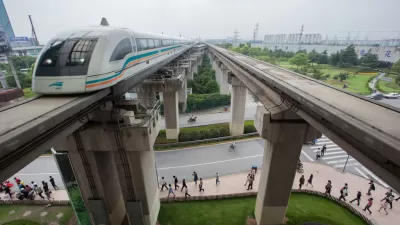Many viewers may not fully appreciate movies as a visual story-telling medium, but that fact came home to me dramatically the other night while watching “Juno,” the off beat, smart and funny film that just snagged a best screenplay Oscar. The deliberate use of architecture and public spaces, in particular, was quite effective although you probably won’t find these references in plot summaries or synopses.
Many viewers may not fully appreciate movies as a visual story-telling medium, but that fact came home to me dramatically the other night while watching "Juno," the off beat, smart and funny film that just snagged a best screenplay Oscar. The deliberate use of architecture and public spaces, in particular, was quite effective although you probably won't find these references in plot summaries or synopses.
Movies, of course, are best viewed reflectively. They aren't social science or history. Nevertheless, the use of image and metaphor can be effective in conveying salient aspects of human relationships. "Juno's" imagery is particularly subtle, but powerful nonetheless.
Juno, for those who haven't seen the movie or read a review, is a 16-year old high school student who becomes pregnant. She decides not to have an abortion, and the movie traces her life through four seasons where she finds an adoptive couple, follows through with the pregnancy, and gives the child up for adoption.
As in any good movie, the human relationships and characters give the story heart. The clever use of set and backgrounds reinforces these plot lines, relationships, and inevitable twists.
So, where's the planning? Juno doesn't live in a well-to-do suburb. That would be too convenient and, at least in movie plot lines, a bit cliché. Rather, she lives in an older, blue-collar central-city neighborhood of walkable single family, detached homes on small lots (mostly likely in St. Paul, Minnesota). Her father is a heating and air conditioning repairman, and her stepmother owns a nail salon.
At first, we think of Juno's family as the dysfunctional one-Dad is an ex-marine, not particularly ambitious near-do well. Juno is the off beat, maladjusted teenager from the first marriage with the frosty relationship with Brenda, the (evil?) step Mom. Juno finds the "perfect" adoptive couple in Vanessa and Mark, two wealthy up-and-coming professionals living in an upscale suburb of St. Cloud about an hour north.
This perception fits the landscape. As Juno is driving to meet Vanessa and Mark, we see her drive through her run-down neighborhood of eclectic single family homes and enter into the wealthier, cookie-cutter sprawl of large, well adorned ones inhabited in St. Cloud, Minnesota.
This sets up a cinematically and artistically visual contrast. It turns out Juno's family, living in the decidedly less affluent neighborhood (albeit early 20th century sprawl), is far more stable, loving, and grounded than the picture perfect couple in the wealthier contemporary suburb.
More intriguing, however, is the director's use of public space as crucial backdrop for the story. Much of the film's action takes place at school, but for my purposes I want to focus on the shopping mall. For the first part of the movie, Vanessa is seen as detached and wistful about the prospect of adopting Juno's child. It's not until a chance encounter between them in the shopping mall that we see the first signs of Vanessa's humanity and longing for motherhood.
First, we see her through Juno's eyes as she is playing with kids in the mall's indoor playground. Then, in one of the movie's most poignant scenes, Vanessa becomes emotionally vulnerable and attached to the child growing inside Juno. The chaos and activity of the mall-a very carefully crafted and scripted public space-is used to provide a context for a spontaneous, highly personal moment between the two characters.
Of course, the shopping mall (as well as modern-day suburbia) is usually depicted by planners as sterile, uninviting and devoid of the characteristics of place that promote human interaction. In "Juno," these places are used to accent the humanity and emotional transformations of the characters and propel the story forward.
This brings me to the main point of today's post. At the end of the day, what is the relationship between people and place?
The message, I think, is simple and relevant: People make places; places do not make people. That's not to say that planning isn't valuable or important. It is.
But the character of the individuals who inhabit our places-whether they are walkable old neighborhoods, "sterile" shopping malls, or upscale sprawling communities-determines the ultimate outcome. People trump place. Stable, successful neighborhoods can be built without sidewalks or transit. High rise apartment buildings can be healthy living environments or death traps, depending on who makes them home and what investments (personal and financial) they make in them. The well planned park is little more than public art unless people use it. Shopping malls serve no purpose unless they can attract people-usually families and teenagers.
Architecture and planning have important roles to play in facilitating the success of these communities, but they cannot determine the outcome. In the parlance of quantitative analysis, good urban planning has a statically significant and positive impact, but the magnitude of the impact is a lot smaller than we may think. Most of what we try to do in planning is to increase the size of the impact, but it won't be able to overcome the dominance of personal character. In my view, that's the reflective reality check for urban planning imbedded in "Juno."

Pennsylvania Mall Conversion Bill Passes House
If passed, the bill would promote the adaptive reuse of defunct commercial buildings.

World's Largest Wildlife Overpass In the Works in Los Angeles County
Caltrans will soon close half of the 101 Freeway in order to continue construction of the Wallis Annenberg Wildlife Crossing near Agoura Hills in Los Angeles County.

U.S. Supreme Court: California's Impact Fees May Violate Takings Clause
A California property owner took El Dorado County to state court after paying a traffic impact fee he felt was exorbitant. He lost in trial court, appellate court, and the California Supreme Court denied review. Then the U.S. Supreme Court acted.

California Grid Runs on 100% Renewable Energy for Over 9 Hours
The state’s energy grid was entirely powered by clean energy for some portion of the day on 37 out of the last 45 days.

New Forecasting Tool Aims to Reduce Heat-Related Deaths
Two federal agencies launched a new, easy-to-use, color-coded heat warning system that combines meteorological and medical risk factors.

AI Traffic Management Comes to Dallas-Fort Worth
Several Texas cities are using an AI-powered platform called NoTraffic to help manage traffic signals to increase safety and improve traffic flow.
City of Costa Mesa
Licking County
Barrett Planning Group LLC
HUD's Office of Policy Development and Research
Mpact Transit + Community
HUD's Office of Policy Development and Research
Tufts University, Department of Urban and Environmental Policy & Planning
City of Universal City TX
ULI Northwest Arkansas
Write for Planetizen
Urban Design for Planners 1: Software Tools
This six-course series explores essential urban design concepts using open source software and equips planners with the tools they need to participate fully in the urban design process.
Planning for Universal Design
Learn the tools for implementing Universal Design in planning regulations.


























